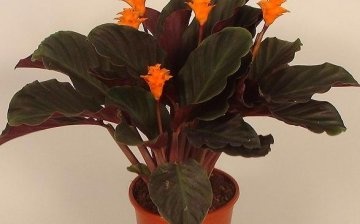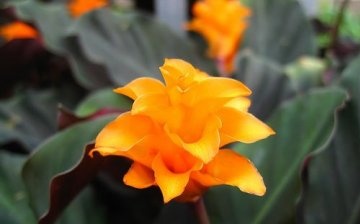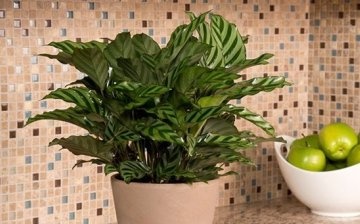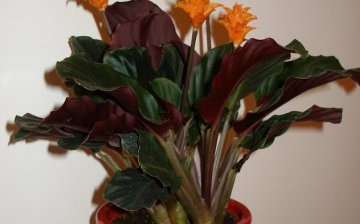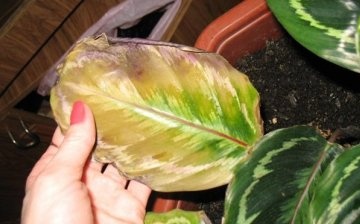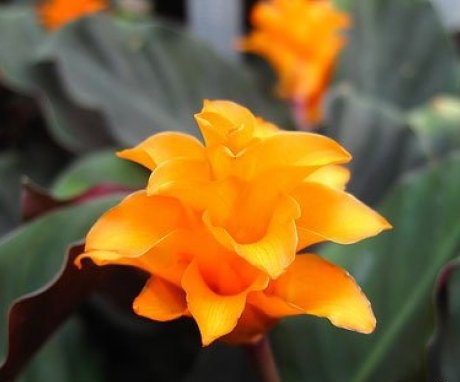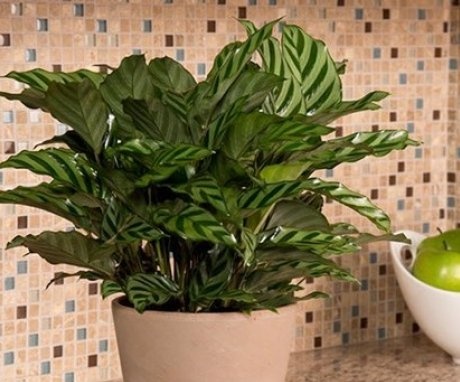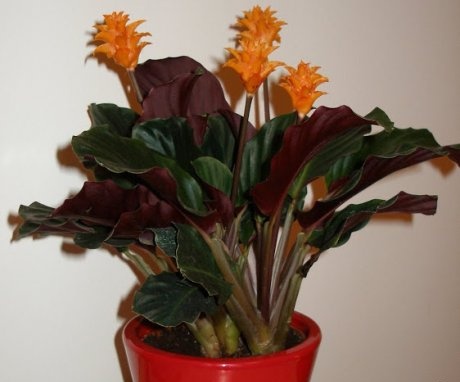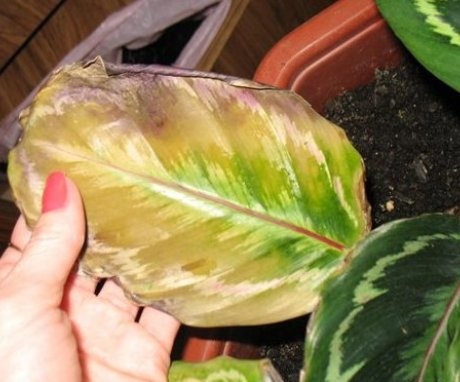Calathea saffron: care, reproduction and pest control
Calathea is a perennial that belongs to the arrowroot family. There are about 130 species native to the wild. They are found in the forests of South America and Africa.
Content:
- General information about the plant
- Types of calathea
- Plant care
- Reproduction of calathea saffron
- Diseases and pests
General information about the plant
Bushes grow in nature up to 100 cm in height. The leaves are large, smooth, wide, oval in shape. The color of the leaves is varied, there are species with spots and patterns on the leaves. It is this decorative feature of the plant appreciated by amateur gardeners. Every year, 5-6 young leaves are formed on a healthy bush.
Another feature of the plant is that the leaves turn to follow the sun.
At night, when the sun hides behind the horizon, the leaves fold up, rising up and pressing one against the other, like two palms in prayer. For this calathea is popularly called a prayer flower. Some varieties have beautiful flowers. The flowering period lasts 4 months, starting in April.
They resemble ears of corn in shape; the petals are colored yellow, red, purple, orange and white. The root system is of two types: tubers and rhizomes.
Types of calathea
The most popular types of calathea:
- Calathea saffron. This species is native to South America, where it grows on the shores of the Amazon. Calathea saffron is prized for its bright orange false flowers, which are located on a high peduncle and are collected in an ear. Real flowers are small, inconspicuous, pale pink or reddish in color. They are located in orange shields of false flowers. The leaves are large, oval in shape, their size reaches 30 cm. On the lower side, they are painted in a dark crimson or burgundy tone. On the upper side, they are velvety, dark green. Calathea needs a short sunny day to bloom, so it opens its buds in the spring or fall months.
- Calathea Makoya. This species is native to the rainforests of Brazil. Beautiful and large leaf plates are located on long petioles. Their upper side is painted in a light green bright tone, along which there is a feathery pattern of dark green color. On the lower side of the sheet, the pattern appears, but only in burgundy tones. It is quite difficult to grow a beautiful healthy bush at home, since the leaves do not tolerate spraying well. Therefore, Kalathea Makoya is mainly grown in greenhouses and conservatories, where high air humidity is constantly maintained.
- Kalateya Varshevich belongs to large species. The size of the bush can reach 100 cm in height. The leaves are large, oblong-oval, slightly wavy edges. On the upper side, the leaf is painted in a dark green tone, and a light green pattern departs from the central vein. The underside is dark purple in color. On short peduncles, also colored in a purple tone, inflorescences in the form of spikelets are located. Pink or cream-colored small flowers are found inside the white bracts. Flowering begins in spring and can last 2-3 weeks.
Plant care
When choosing a place in an apartment or house to place a calathea, some plant preferences must be taken into account. Contrary to the general opinion that this type of plant can grow well in a shaded place, it is advisable to choose a well-lit room for calathea.
Leaves in the shade will lose their saturation, brightness and variegation, and the flower itself will develop slowly.
But direct sunlight should not fall on the plant, as burns will immediately appear on the leaves. Also, a very bright area can dull the color of the leaves. The best place will be partial shade, where there will be good lighting for 2-3 hours a day.
Watering the plant:
- It is necessary to water the calathea regularly and in moderation, the time for watering is determined by the drying of the top layer.
- When 2-4 cm of the soil is dry, you can make the next watering.
- With constant waterlogging of the soil, the plant may die, as the roots quickly rot.
- When the soil dries out and irregular watering, the leaves wither and fall, with constant incorrect moistening of the soil of the plant, the lower leaves begin to die off and over time the plant may also die.
- In the cold autumn winter months, watering is reduced.
- Water for irrigation must be defended. The water drawn from the tap will be hard for the calathea, which can lead to growth retardation and disease.
The temperature regime for calathea is very important. But sudden changes in temperature can lead to negative consequences for the plant. Therefore, the flower is best kept at + 20- + 22 degrees. The air humidity should also be high, about 80%. At home, this can be done with a humidifier. If such a device is not available, then you can regularly spray the leaves with soft warm water from a spray bottle.
Calathea needs annual feeding:
- Without fertilization, the leaves lose their color and richness.
- Common foliar fertilizers work well.
- Top dressing begins in the spring, is carried out once every 2 weeks and ends in the middle of summer. But the dosage should be small, since when a concentrated fertilizer is applied, the plant gets sick.
- Saffron calathea and all types of flowering calatheas are fed with fertilizers for flowering plants.
Calathea is transplanted every year for young plants and once every 2-3 years for adult bushes, while completely replacing the entire soil. The substrate should be slightly acidic and loose.
In nature, Calathea grows in forests, where the soil is light and breathable, so at home it is necessary to carefully select the substrate, and it should be as close to natural conditions as possible.
The transplant is best done in early spring, when the plant is still half asleep. A thick layer of drainage must be placed on the bottom of the pot so that the water does not stagnate.
Reproduction of calathea saffron
Reproduction of calathea is carried out in two ways: by seeds and dividing the bush... With the help of seeds, the plant is propagated in greenhouses and nurseries. For home conditions, this process is quite laborious and it is difficult to find good quality seeds.
By dividing the plant, all types of calathea multiply. This process can be carried out during transplanting a bush and only with adult plants.
The bush is removed from the pot and, depending on the size, is divided into 2-4 new ones.
Drainage is poured into the pots and prepared soil on top of it. Soil works well for azaleas. Further, a daughter plant is placed and the rhizome is covered with earth. It is advisable to make a small greenhouse for the planted plants or put it in a place with the required temperature regime and regularly spray it with warm water.
Diseases and pests
Often the tips of the leaves begin to dry out in calathea, especially in winter, when the heating is turned on. This indicates that the plant is not getting enough humid air.If the leaves are very dry, they must be removed, and the remaining ones must be moistened with soft warm water using a spray bottle or put a humidifier.
If the leaves turn yellow, this indicates a lack of nutrients. Therefore, the plant needs to be fed with fertilizers.
Any fertilizer will do for deciduous plants, the dosage is low. Also, calathea can be exposed mealy mite attack, whitefly or scale insects. When the first signs appear, the affected plant and all neighboring and closely located flowers and bushes must be treated with special preparations against pests. You can buy them at any gardening store.
More information about calatheia can be found in the video.



